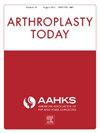Validation of a Novel Landmark-guided Intra-articular Postero-medial Surgeon-administered Injection Technique
IF 1.5
Q3 ORTHOPEDICS
引用次数: 0
Abstract
Background
This study aimed to define an intra-articular surgeon-administered technique that may be comparable to ultrasound (US)-guided adductor canal block (ACB).
Methods
Five cadaver lower limbs were examined. An anesthesiologist administered a US-guided ACB using 20 mL of dilute indocyanine dye. An orthopedic surgeon performed a medial parapatellar arthrotomy and introduced an 18-gauge needle 1-2 cm proximal to the palpated adductor tubercle angled posteromedially. Needle position and dye spread were fluoroscopically documented.
Results
This technique consistently reached the infrapatellar branch of the saphenous nerve, nerve to the vastus medialis muscle, and posterior capsule, with minimal proximal dye spread.
Conclusions
This technique may be an efficient complement to ACB or surgeon infiltration or an alternative to US-guided ACB when it is not available.
求助全文
约1分钟内获得全文
求助全文
来源期刊

Arthroplasty Today
Medicine-Surgery
CiteScore
2.90
自引率
0.00%
发文量
258
审稿时长
40 weeks
期刊介绍:
Arthroplasty Today is a companion journal to the Journal of Arthroplasty. The journal Arthroplasty Today brings together the clinical and scientific foundations for joint replacement of the hip and knee in an open-access, online format. Arthroplasty Today solicits manuscripts of the highest quality from all areas of scientific endeavor that relate to joint replacement or the treatment of its complications, including those dealing with patient outcomes, economic and policy issues, prosthetic design, biomechanics, biomaterials, and biologic response to arthroplasty. The journal focuses on case reports. It is the purpose of Arthroplasty Today to present material to practicing orthopaedic surgeons that will keep them abreast of developments in the field, prove useful in the care of patients, and aid in understanding the scientific foundation of this subspecialty area of joint replacement. The international members of the Editorial Board provide a worldwide perspective for the journal''s area of interest. Their participation ensures that each issue of Arthroplasty Today provides the reader with timely, peer-reviewed articles of the highest quality.
 求助内容:
求助内容: 应助结果提醒方式:
应助结果提醒方式:


